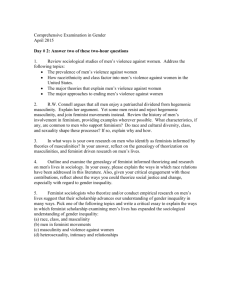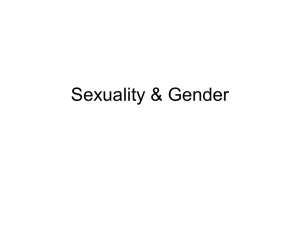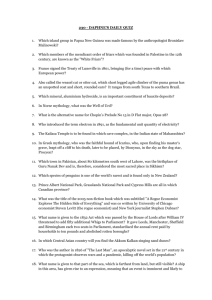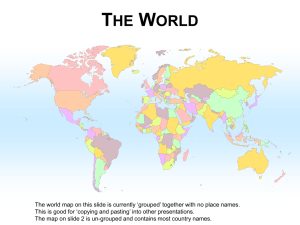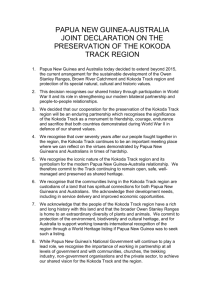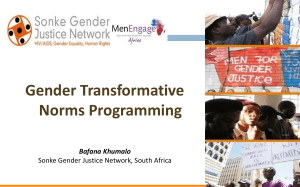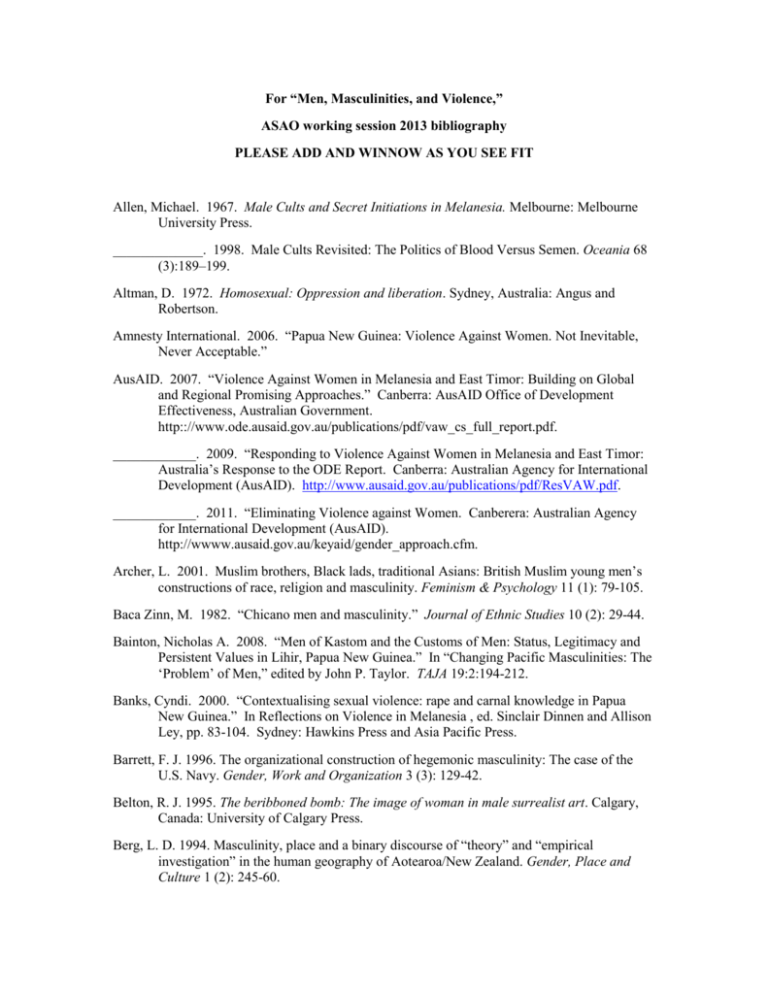
For “Men, Masculinities, and Violence,”
ASAO working session 2013 bibliography
PLEASE ADD AND WINNOW AS YOU SEE FIT
Allen, Michael. 1967. Male Cults and Secret Initiations in Melanesia. Melbourne: Melbourne
University Press.
_____________. 1998. Male Cults Revisited: The Politics of Blood Versus Semen. Oceania 68
(3):189–199.
Altman, D. 1972. Homosexual: Oppression and liberation. Sydney, Australia: Angus and
Robertson.
Amnesty International. 2006. “Papua New Guinea: Violence Against Women. Not Inevitable,
Never Acceptable.”
AusAID. 2007. “Violence Against Women in Melanesia and East Timor: Building on Global
and Regional Promising Approaches.” Canberra: AusAID Office of Development
Effectiveness, Australian Government.
http:://www.ode.ausaid.gov.au/publications/pdf/vaw_cs_full_report.pdf.
____________. 2009. “Responding to Violence Against Women in Melanesia and East Timor:
Australia’s Response to the ODE Report. Canberra: Australian Agency for International
Development (AusAID). http://www.ausaid.gov.au/publications/pdf/ResVAW.pdf.
____________. 2011. “Eliminating Violence against Women. Canberera: Australian Agency
for International Development (AusAID).
http://wwww.ausaid.gov.au/keyaid/gender_approach.cfm.
Archer, L. 2001. Muslim brothers, Black lads, traditional Asians: British Muslim young men’s
constructions of race, religion and masculinity. Feminism & Psychology 11 (1): 79-105.
Baca Zinn, M. 1982. “Chicano men and masculinity.” Journal of Ethnic Studies 10 (2): 29-44.
Bainton, Nicholas A. 2008. “Men of Kastom and the Customs of Men: Status, Legitimacy and
Persistent Values in Lihir, Papua New Guinea.” In “Changing Pacific Masculinities: The
‘Problem’ of Men,” edited by John P. Taylor. TAJA 19:2:194-212.
Banks, Cyndi. 2000. “Contextualising sexual violence: rape and carnal knowledge in Papua
New Guinea.” In Reflections on Violence in Melanesia , ed. Sinclair Dinnen and Allison
Ley, pp. 83-104. Sydney: Hawkins Press and Asia Pacific Press.
Barrett, F. J. 1996. The organizational construction of hegemonic masculinity: The case of the
U.S. Navy. Gender, Work and Organization 3 (3): 129-42.
Belton, R. J. 1995. The beribboned bomb: The image of woman in male surrealist art. Calgary,
Canada: University of Calgary Press.
Berg, L. D. 1994. Masculinity, place and a binary discourse of “theory” and “empirical
investigation” in the human geography of Aotearoa/New Zealand. Gender, Place and
Culture 1 (2): 245-60.
2
Berger, Maurice, Brian Wallis, and Simon Watson, eds. 1995. Constructing Masculinity. New
York: Routledge.
Besnier, Niko. 1994. Polynesian Gender Liminality in Time and Space. In Third Sex, Third
Gender: Beyond Sexual Dimorphism in Culture and History, edited by
Gilbert Herdt, 285–328. New York: Zone Books.
_____________. 1997. “Sluts and Superwomen: The Politics of Gender Liminality in Urban
Tonga.” Ethnos 62 (1–2): 5–31.
_____________. 2002. Transgenderism, Locality, and the Miss Galaxy Beauty Pageant in
Tonga. American Ethnologist 29 (4): 534–566.
_____________________. 2011. On the Edge of the Global: Modern Anxieties in a Pacific
Island Nation. Stanford: Stanford University Press.
____________, and Susan Brownell. 2012. “Sport, Modernity, and the Body.” Annual Review
of Anthropology. Final version available online 9/17/12.
Beynon, John. 2002. Masculinities in Culture. Issues in Cultural and Media Studies.
Buckingham, U.K., and Philadelphia: Open University Press.
Bird, S. R. 1996. “Welcome to the men’s club: Homosociality and the maintenance of
hegemonic masculinity.” Gender & Society 10 (2): 120-32.
Bourdieu, Pierre. 2001. Masculine Domination. Translated by Richard Nice. Stanford: Stanford
University Press.
Bradley, Christine. 1994a. “Why male violence against women is a development issue:
Reflections from Papua New Guinea.” In Women and Violence, ed. Miranda Davies, 10–
26. London: Zed Books, Ltd.
____________. 1994b. Why Male Violence Against Women?: Methodological and Personal
Perspectives. London: Sage Publications.
____________. 2001. Family and Sexual Violence in Papua New Guinea: An Integrated Longterm Strategy. Waigani: Institute of National Affairs.
Borrey, Anou. 2000. “Sexual violence in perspective: the case of Papua New Guinea. In
Reflections on Violence in Melanesia, edited by Sinclair Dinnen and Allison Ley, pp.
105-118. Sydney: Hawkins Press and Asia Pacific Press.
Braudy, Leo. 2005. From Chivalry to Terrorism: War and the Changing Nature of Masculinity.
Vintage.
Brison, Karen. 1995. “Changing Constructions of Masculinity in a Sepik Society.” Ethnology
34(3):155-175.
Brod, H. 1987. The making of masculinities: The new men’s studies. Boston: Allen and Unwin.
. 1994. “Some thoughts on some histories of some masculinities: Jews and other others.” In
Theorizing masculinities, edited by D. S. David and R. Brannon. Thousand Oaks, CA:
Sage.
Campbell, C. 1997. “Migrancy, Masculine Identities and AIDS: The Psychosocial Context of
3
HIV Transmission on the South African Gold Mines.” Social Science and Medicine
45(2):273-281.
Campbell, H. 2000. “The glass phallus: Pub(lic) masculinity and drinking in rural New
Zealand.” Rural Sociology 65 (4):562-81.
Carrigan, T., R.W. Connell, and J. Lee. 1985. “Toward a new sociology of masculinity. “
Theory and Society 14 (5): 551-604.
Cavender, G. 1999. “Detecting masculinity.” In Making trouble: Cultural constructions of
crime, deviance and control, edited by J. Ferrell and N. Websdale. New York: Aldine de
Gruyter.
Chant, Sylvia. 2000. “Men in Crisis? Reflections on Masculinities, Work and Family in
Northwest Costa Rica.” European Journal of Development Research 12(2):199-218.
Chant, Sylvia, and Matthew C. Gutmann. 2000. Mainstreaming men into gender and
development: debates, reflections, and experiences. Oxfam: Oxford.
Chant, Sylvia, and Matthew C. Gutmann. 2002/2005. “Men-streaming” Gender? Questions for
Gender and Development Policy in the Twenty-first Century.” Reprinted and abridged in
The Anthropology of Development and Globalization: From Classical Political Economy
to Contemporary Neoliberalism, edited by Marc Edelman and Angelique Haugerud, pp.
240-249. Malden, MA: Blackwell. Initially published in Progress in Development
Studies 2(4):269-282.
Charlesworth, H., and C. Chinkin. 1994. “Violence Against Women: A Global Issue.” In
Women, Male Violence and the Law, ed. by J. Stubbs. Sydney: Federation Press.
Cheng, C., ed. 1996. Masculinities in organizations. Thousand Oaks, CA: Sage.
Clark, Jeffrey. 1989. “The Incredible Shrinking Men: Male Ideology and development in a
Southern Highlands Society.” Canberra Anthropology 12(1&2):120-143.
Cleaver, F. 2002. Men and Masculinities: New Directions in Gender and Development. In F.
Cleaver (ed.). Making Men Matter: Men, Masculinities and Gender Relations in
Development. London: Zed Books, 1–27.
Collier, R. 1998. Masculinities, crime and criminology: Men, heterosexuality and the
criminal(ised) other. London: Sage.
Connell, R. W. 1987. Gender and power. Sydney, Australia: Allen and Unwin.
____________. 1990. “An iron man: The body and some contradictions of hegemonic
masculinity.” In Sport, men and the gender order, edited by M. Messner and D. Sabo.
Champaign, IL: Human Kinetics Books.
____________. 1995. Masculinities. Sydney, NSW: Allen and Unwin.
____________. 1998. “Masculinities and globalization.” Men and Masculinities 1 (1): 3-23.
____________. 2002. Gender. Cambridge, UK: Polity Press.
____________. 2003. “Masculinities, change and conflict in global society: Thinking about the
future of men’s studies.” Journal of Men’s Studies 11 (3): 249-266.
4
___________. 2003. “The Role of Men and Boys in Achieving Gender Equality. Prepared for
United Nations Expert Group Meeting on ‘The Role of Men and Boys in Achieving
Gender Equality’, Brasilia, Brazil, 21–24/10/2003. New York: United Nations, 2003.
<http://www.un.org/womenwatch/daw/egm/men-boys2003/Connell-bp.pdf> viewed
15/01/2012.
___________. 2005. “Globalization, Imperialism, and Masculinities.” In Handbook of Studies
on Men & Masculinities, edited by Michael S. Kimmel, Jeff Hearn, and R. W. Connell,
pp. 71-89. Thousand Oaks, CA: Sage Publication.
___________, and James W. Messerschmidt. 2005. “Hegemonic Masculinity: Rethinking the
Concept. Gender and Society 19:829-859.
___________, and J. Wood. 2005. “Globalization and business masculinities.” Men and
Masculinities 7(4): 347-64.
Consalvo, M. 2003. “The monsters next door: Media constructions of boys and masculinity.”
Feminist Media Studies 3 (1): 27-46.
Counts, Dorothy Ayers. 1990. “Domestic Violence in Oceania. Conclusion.” Pacific Studies
13(3): 225–254.
___________. 1992. “‘All Men Do It’: Wife-Beating in Kaliai, Papua New Guinea.” In
Sanctions and Sanctuary: Cultural Perspectives on the Beating of Wives, ed. by Dorothy
Ayers Counts, Judith K. Brown and Jacquelyn C. Campbell, 63–76. Boulder and Oxford:
Westview Press.
___________. 1993. “The fist, the stick and the bottle of bleach: wife bashing and female
suicide in a Papua New Guinea Society.” In Contemporary Pacific Societies: Studies in
Development and Change, edited by Victoria S. Lockwood, Tom G. Harding and Ben J,
Wallace, pp. 249-259. New Jersey: Prentice Hall.
___________. 1999 “’All men do it’: wife beating in Kaliai, Papua New Guinea. In To Have
and to Hit: Cultural Perspectives on Wife Beating, edited by Dorothy A. Counts, Judith
K. Brown, and Jacqueline C. Campbell, pp. 73-86. Urbana: University of Illinois Press.
Counts, Dorothy A., Judith K. Brown and Jacquelyn C. Campbell. 1992. Sanctions and
Sanctuary: Cultural Perspectives on the Beating of Wives. Boulder: Westview Press.
__________, Judith K. Brown, and Jacquelyn C. Campbell, eds. 1999. To Have and to Hit:
Cultural Perspectives on Wife Beating. Urbana: University of Illinois Press.
Cummings, Maggie. 2008. “The trouble with trousers: gossip kastom and sexual culture in
Vanuatu. In Making Sense of AIDS: Culture, Sexuality and Power in Melanesia, edited
by Leslie Butt and Richard Eves, pp. 133-149. Honolulu: University of Hawai’i Press.
Das, Veena. 2008. “Violence, Gender, and Subjectivity.” Annual Review of Anthropology
37:283-299.
Dasgupta, R. 2000. Performing masculinities? The “salaryman” at work and play. Japanese
Studies 20 (2): 189-200.
Davis, A. 1983. Women, race, and class. New York: Vintage.
Demetrakis, Demetriou Z. 2001. “Connell’s concept of hegemonic masculinity: a critique.”
5
Theory and Society 30(3):337-61.
Denborough, D. 1996. “Step by step: Developing respectful and effective ways of working with
young men to reduce violence.” In Men’s ways of being, edited by C. McLean, M.
Carey, and C. White. Boulder, CO: Westview.
Diaz, Vicente. 2002. “’Fight Boys Till the Last’: Football and the Remasculinization of
Indigeneity in Guam.” In Pacific Diaspora: Island Peoples in the United States and the
Pacific, edited by Paul Spickard, Joanne Rondilla, and Deborah Hippolite Wright, 167–
194. Honolulu: University of Hawai‘I Press.
Dickerson--Putnam, Jeanette. 1998. “Men and the Development Experience in an Eastern
Highlands Community.” In Modern Papua New Guinea, edited by Laura ZimmerTamakoshi, pp. 231-252. Kirksville, Missouri: Thomas Jefferson University Press at
Truman State University.
Dinnen, Sinclair. 2000. “Violence and Governance in Melanesia: An Introduction.” In
Reflections on Violence in Melanesia, edited by Sinclair Dinnen and A. Ley, pp. 1-16.
_____________, and Allison Ley, eds. 2000. Reflections on Violence in Melanesia. Syndey:
Hawkins Press and Asia Pacific Press.
_____________, and Edwina Thompson. 2004. “Gender and Small Arms Violence in Papua
New Guinea. State, Society and Governance in Melanesia Discussion Paper 2004/8.”
Canberra: Research School of Pacific and Asian Studies, Australian National University.
Donaldson, M. 1991. Time of our lives: Labor and love in the working class. Sydney, Australia:
Allen and Unwin.
_____________. 1993. “What is hegemonic masculinity?” Theory and Society 22:643-657.
_____________, and S. Poynting. 2004. “The time of their lives: Time, work and leisure in the
daily lives of ruling-class men.” In Ruling Australia: The power, privilege & politics of
the new ruling class, edited by N. Hollier. Melbourne: Australian Scholarly.
Dowsett, Gary. 2006. “Moving Masculinities and Social Change: Why Do Men Matter?”
Gender Relations Centre Working Paper 20. Originally presented as keynote paper at the
“Moving Masculinities: Crossing Regional and Historical Borders” international
conference hosted by the Gender Relations Centre, The Australian National University,
Canberra, 29 Nov–2 Dec. 2005.
Elliston, Deborah. 1995. “Erotic Anthropology: ‘Ritualized Homosexuality’ in Melanesia and
Beyond.” American Ethnologist 22(4):848–867.
Eisenstein, Z. R. 1979. Capitalist patriarchy and the case for socialist feminism. New York:
Monthly Review Press.
Esplen, Emily. 2006. “Engaging Men in Gender Equality: Positive Strategies and Approaches Overview and Annotated Bibliography.” Institute of Development Studies, University of
Sussex. Available on line.
Eves, Richard. 2006. “Exploring the Role of Men and Masculinities in Papua New Guinea in the
21st century: How to Address Violence in Ways that Generate Empowerment for Both
Men and Women.” Sydney: Caritas Australia.
6
http://www.baha.com.pg/downloads/Masculinity%20and%20Violence%20in%20PNG.pd
f.
____________. 2010. “Masculinity Matters: Men, Gender-Based Violence and the AIDS
Epidemic in Papua New Guinea.” In Civil Insecurity: Law, Order and HIV in Papua
New Guinea, edited by Vicki Luker and Sinclair Dinnen, pp. 47-79. Canberra: ANU E
Press.
____________. 2012. “Christianity, Masculinity and Gender Violence in Papua New Guinea.”
SSGM Discussion Paper 2012/2.
Ferguson, H. 2001. Men and masculinities in late-modern Ireland. In A man’s world? changing
men’s practices in a globalized world, edited by B. Pease and K. Pringle. London: Zed
Books.
Ferguson, Kathy E, and Phyllis Turnbull. 1999. Oh Say, Can You See? The Semiotics of the
Military in Hawai‘i. Minneapolis: University of Minnesota Press.
Fife, Wayne. 1995. Models for Masculinity in Colonial and Postcolonial Papua New
Guinea. The Contemporary Pacific 7:277–302.
Finney, Ben. 1973. Big-Men and Business: Entrepreneurship and Economic Growth in the New
Guinea Highlands. Honolulu: University Press of Hawaii.
____________. 1993. “From the Stone Age to the Age of Corporate Takeovers.” In
Contemporary Pacific Societies: Studies in Development and Change, edited by Victoria
S. Lockwood et al., pp. 102-116. Englewood Cliffs, NJ: Prentice Hall.
Flood, M. 2002–2003. “Engaging Men: Strategies and Dilemmas in Violence Prevention
Education Among Men.” Women Against Violence: A Feminist Journal 13:25–32.
_____________. 2007. “Involving Men in Gender Policy and Practice.” Critical Half 5(1):9–
13.
Friedman, R. M., and L. Lerner. 1986. “Toward a new psychology of men: psychoanalytic and
social perspectives.” Special issue, Psychoanalytic Review 73(4).
Garap, Sarah. 2000. Struggles of Women and Girls – Simbu Province, Papua New Guinea. In
Reflections on Violence in Melanesia, edited by Sinclair Dinnen and Allison Ley, 159–
171. Sydney: Hawkins Press/Asia Pacific Press.
____________. 2004. “Kup Women for Peace: Women Taking Action to Build Peace and
Influence Community Decision-Making. State Society and Governance in Melanesia.”
Discussion Paper. 2004/4. Canberra: Research School of Pacific and Asian Studies,
Australian National University.
George, Nicole. 2006. “Situating Agency: Gender Politics and Circumstance in Fiji.” PhD
thesis, International Relations, Research School of Pacific and Asian Studies. The
Australian National University.
_____________. 2012. Situating Women: Gender Politics and Circumstances in Fiji. Canberra:
ANU E Press, in press.
Gerschick, T. J., and A. S. Miller. 1994. Gender identities at the crossroads of masculinity and
physical disability. Masculinities 2 (1): 34-55.
7
Gibbs, Philip. 2010. “Witchkilling and engendered violence in Simbu.” Catalyst 40(1):24-64.
Goddard, Michael. 2005. “The Rascal Road: Crime, Prestige, and Development in Papua New
Guinea.” The Contemporary Pacific 7(1):55-80.
Godelier, Maurice. 1986. The Making of Great Men: Male Domination and Power Among the
New Guinea Baruya. Cambridge: Cambridge University Press.
_____________, and Marilyn Strathern, eds. 1991. Big Men and Great Men: Personifications of
Power in Melanesia. Cambridge: Cambridge University Press.
Goldstein, Joshua S. 2003. War and Gender: How Gender Shapes the War System and Vice
Versa. Cambridge: Cambridge University Press.
Greig, A., M. Kimmel, and J. Lang. 2000. Men, masculinities and development: broadening our
work towards gender equality. Monograph no. 10. New York: NDP/GIDP.
Gutmann, Matthew C. 1996. The Meanings of Macho: Being a Man in Mexico City. Berkeley:
University of California Press.
____________. 1997. “Trafficking in Men: The Anthropology of Masculinity.” Annual Review
of Anthropology 26:385-409.
Halberstam, J. 1998. Female masculinity. Durham, NC: Duke University Press.
Haley, Nicole. 2008. “Sung Adornment Changing Masculinities at Lake Kopiago, Papua New
Guinea. In Changing Pacific Masculinities, edited by John P. Taylor. Special issue of
The Australian Journal of Anthropology 19(2):213-229.
Hanke, R. 1992. “Redesigning men: hegemonic masculinity in transition.” In Men, masculinity,
and the media, edited by S. Craig. Newbury Park, CA: Sage.
Hawkesworth, M. 1997. “Confounding gender.” Signs: Journal of Women in Culture and
Society 22 (3):649-685.
Hearn, J. 1996. “Is masculinity dead? A critique of the concept of masculinity/masculinities.” In
Understanding masculinities: social relations and cultural arenas, edited by M. Mac an
Ghaill. Buckingham, UK: Open University Press.
_____________. 2004. “From hegemonic masculinity to the hegemony of men.” Feminist
Theory 5(1):49-72.
Heinonen, Nea. “Balancing the gender equation--men’s important role in achieving gender
equality in development co-operation.” Available on line.
Herdt, Gilbert H. 1981. Guardians of the flutes: idioms of masculinity. New York: McGraw-Hill.
_____________, ed. 1982. Rituals of Manhood: Male Initiation in Papua New Guinea.
Berkeley: University of California Press.
______________, ed. 1984. Ritualized Homosexuality in Melanesia. Berkeley: University of
California Press.
_____________, and Stephen C. Leavitt, editors. 1998. Adolescence in Pacific Island Societies.
ASAO Monograph. Pittsburgh: University of Pittsburgh Press.
8
_____________. 1999. “Sambia Sexual Culture.” In Sambia Sexual Culture: Essays from the
Field, pp. 56-88. Chicago: University of Chicago Press.
_____________. 2006. The Sambia: Ritual, Sexuality, and Change in Papua New Guinea, 2nd
edition. Belmont, CA: Thomson/Wadworth.
_____________, and Fitz John Porter Poole. 1982. Sexual antagonism, gender, and cultural
reality. Department of Anthropology, University of Adelaide.
Hokowhitu, Brendan. 2004. “Tackling Mäori Masculinity: A Colonial Genealogy of Savagery
and Sport.” The Contemporary Pacific 16:259–284.
Higate, P. R. 2003. Military masculinities: identity and the state. London: Praeger.
Hogan, Evelyn. 1985. “Controlling the bodies of women: Reading gender ideologies in Papua
New Guinea.” In Women and Politics in Papua New Guinea, ed. Maev O’Collins et al.
Working Paper No. 6, 54–71. Canberra: Department of Political and Social Change,
Australian National University.
Hooper, C. 1998. “Masculinist practices and gender politics: The operation of multiple
masculinities in international relations.” In The “man” question in international
relations, edited by M. Zalewski and J. Parpart. Boulder: Westview Press.
_______________. 2000. “Masculinities in transition: the case of globalization.” In Gender and
global restructuring, edited by M. H. Marchand and A. S. Runyan. London: Routledge.
_______________. 2001. Manly states: masculinities, international relations, and gender
politics. New York: Columbia University Press.
Human Rights Watch. 2005. “’Making Their Own Rules’: Police Beatings, Rape, and Torture of
Children in Papua New Guinea. New York: Human Rights Watch.
_______________. 2006. “Still ‘Making Their Own Rules’: Ongoing Impunity for Police
Beatings, Rape, and Torture of Children in Papua New Guinea.” New York: Human
Rights Watch.
International Planned Parenthood Federation (IPPF). 1996. Africa Link: Just for Men: Involving
Men in Sexual and Reproductive Health Programmes. London: IPPE.
Jansen, S. C., and D. Sabo. 1994. “The sport-war metaphor: hegemonic masculinity, the PersianGulf war, and the new world order.” Sociology of Sport Journal 11 (1):1-17.
Jefferson, T. 1994. “Theorizing masculine subjectivity.” In Just boys doing business? Men,
masculinities and crime, edited by T. Newburn and E. A. Stanko. London: Routledge.
______________. 2002. “Subordinating hegemonic masculinity.” Theoretical Criminology 6
(1):63-88.
Jenkins, Carol (and The National Sex and Reproduction Research Team). 1994. National Study
of Sexual and Reproductive Knowledge and Behaviour in Papua New Guinea. Papua
New Guinea Institute of Medical Research Monograph 10. Papua New Guinea Institute
of Medical Research.
9
Jolly, Margaret. 2000. “Epilogue: Further Reflections on Violence in Melanesia. “ In
Reflections on Violence in Melanesia, edited by Sinclair Dinnen and Allison Ley, pp.
305–324. Sydney: Hawkins Press and Asia Pacific Press.
_____________. 2005. “Beyond the Horizon? Nationalisms, Feminisms, and Globalization in
the Pacific.” In Outside Gods: History Making in the Pacific, edited by Martha Kaplan.
Special issue of Ethnohistory 52 (1):137–166.
_____________, ed. 2008. “Re-membering Oceanic Masculinities.” In “Moving Masculinities:
Memories and Bodies across Oceania.” The Contemporary Pacific (Special Issue)
20(1):1-14.
____________, ed. 2012a. Engendering Violence in Papua New Guinea. Canberra: ANU E
Press.
____________. 2012b. “Introduction--Engendering Violence in Papua New Guinea: Persons,
Power and Perilous Transformations.” In Engendering Violence in Papua New Guinea,
pp. 1-45. Canberra: ANU E Press.
Josephides, Lisette. 1994. “Gendered violence in a changing society: the case of urban Papua
New Guinea.” Journal de la Societe des Oceanistes 2:187-196.
Journal of Culture, Society and Masculinities
Journal of Men’s Studies
Kaufman, Michael. 1994. “Men, feminism, and men’s contradictory experiences of power.” In
Theorizing Masculinities, ed. Harry Brod and Michael Kaufman, 59–85. Thousand Oaks,
CA: Sage Publications.
____________. 1999. “The 7 P’s of Men’s Violence, 1998 Workshop Organised by Save the
Children (UK), Kathmandu, Nepal.” http://www.michaelkaufman.com/1999/10/04/the7-ps-of-mens-violence.
Keesing, Roger. 1985. “Killers, Big Men, and Priests on Malaita: Reflections on a Melanesian
Troika System.” Ethnology 24:237–252.
Kempf, Wolfgang. 2002. “The Politics of Incorporation: Masculinity, Spatiality and Modernity
among the Naing of Papua New Guinea. Oceania 73(1):56-77.
Kessler, S. J., D. J. Ashenden, R.W. Connell, and G.W. Dowsett. 1982. Ockers and discomaniacs. Sydney: Inner City Education Center.
Kimmel, M. S. 1987. “Rethinking ‘masculinity’: New directions in research.” In Changing
men: New directions in research on men and masculinity, edited by M. S. Kimmel.
Newbury Park, CA: Sage.
____________. 2005. “Globalization and its mal(e)contents: the gendered moral and political
economy of terrorism.” In Handbook of studies on men & masculinities, edited by M. S.
Kimmel, J. Hearn, and R.W. Connell. Thousand Oaks, CA: Sage.
____________, Jeff Hearn, and R. W. Connell, eds. Handbook of Studies on Men and
Masculinities. London: Sage.
____________, and M. Mahler. 2003. “Adolescent masculinity, homophobia, and violence:
10
Random school shootings, 1982-2001.” American Behavioral Scientist 46 (10):1439458.
____________, and Amy Aronson, eds. 2004. Men and Masculinities: A Social, Cultural, and
Historical Encyclopedia. Santa Barbara, CA: ABC-CLIO.
Knauft, Bruce M. 1997. “Gender Identity, Political Economy and Modernity in Melanesia and
Amazonia.” The Journal of the Royal Anthropological Institute 3(2):233–259.
____________. 1999. From Primitive to Postcolonial. Ann Arbor, MI: University of Michigan
Press.
____________. 2010. The Gebusi: Lives Transformed in a Rainforest World. Second edition.
New York: McGraw-Hill.
____________. 2011. “Men, Modernity and Melanesia.” In Echoes of the Tambaran:
Masculinity, History and the Subject in the Work of Donald F. Tuzin, edited by David
Lipset and Paul Roscoe. ANU E Press.
Kulick, Don. 1993. “Heroes from Hell: Representations of ‘Raskals’ in a Papua New Guinean
Village.” Anthropology Today 9(3):9-14.
Kupers, T. A. 1 993. Revisioning men’s lives: Gender, intimacy, and power. New York:
Guilford.
Langness, Lewis L.. 1967. “Sexual antagonism in the New Guinea Highlands. A Bena Bena
example.” Oceania 37:161-177.
____________. 1999. Men and ‘Woman’ in Papua New Guinea. Novato, California: Chandler
and Sharp.
Law, Robin, Hugh Campbell, and John Dolan, eds. 1999. Masculinities in Aotearoa/New
Zealand. Palmerston North, New Zealand. Dunmore Press.
Layard, John. 1942. Stone Men of Malekula. London: Chatto & Windus.
Lea, S., and T. Auburn. 2001. “The social construction of rape in the talk of a convicted rapist.”
Feminism & Psychology 11 (1): 11-33.
Lepani, Katherine. 2008. “Mobility, Violence and the Gendering of HIV in Papua New Guinea.”
In “Changing Pacific Masculinities,” edited by John P. Taylor. The Australian Journal of
Anthropology 19(2):150-164.
Light, R., and D. Kirk. 2000. “High school rugby, the body and the reproduction of hegemonic
masculinity.” Sport, Education and Society 5(2):163-76.
Lipset, David. 1997. Mangrove Man: Dialogics of Culture in the Sepik Estuary. Cambridge:
Cambridge University Press.
Mac an Ghaill, M. 1994. The making of men: Masculinities, sexualities and schooling.
Buckingham, UK: Open University Press.
11
MacInnes, J. 1998. The end of masculinity: the confusion of sexual genesis and sexual difference
in modern society. Buckingham, UK: Open University Press.
Macintyre, Martha. 1995. “Violent bodies and vicious echanges: objectification and
personification in the Massim.” In Bodies, Selves, Emotions. Special issue of Social
Analysis 37:29-43.
_____________. 1998. “The persistence of inequality: women in Papua New Guinea since
independence.” In Modern Papua New Guinea, edited by Laura Zimmer-Tamakoshi, pp.
211-231. Missouri: Thomas Jefferson University Press.
_____________. 2006. “Indicators of violence against women.” Development Bulletin 71:6163.
_____________. 2008. “Police and Thieves, Gunmen and Drunks: Problems with Men and
Problems with Society in Papua New Guinea.” In “Changing Pacific Masculinities,”
edited by John P. Taylor. The Australian Journal of Anthropology (TAJA) 19(2):179193.
Mageo, Jeannette M. 1992. “Male Transvestism and Cultural Change in Samoa.” American
Ethnologist 19:443–459.
_____________. 1996. “Samoa, on the Wilde Side: Male Transvestism, Oscar Wilde, and
Liminality in Making Gender.” Ethos 24 (4): 588–627.
Malesevic, Sinisa. 2010. The Sociology of War and Violence. Cambridge: Cambridge
University Press.
Martin, P.Y. 1998. “Why can’t a man be more like a woman? Reflections on Connell’s
masculinities.” Gender & Society 12 (4): 472-474.
____________. 2001. “’Mobilizing masculinities’: women’s experiences of men at work.”
Organizations 8 (4):587-618.
Marshall, Mac. 1979. Weekend Warriors: Alcohol in a Micronesian Culture. Palo Alto:
Mayfield.
____________, ed. 1982. Through a Glass Darkly: Beer and Modernization in Papua New
Guinea. Boroko: Institute of Applied Social and Economic Research.
McLeod, A., and Martha Macintyre. 2010. “The Royal Papua New Guinea Constabulary.” In
Civic Insecurity: Law, Order and HIV in Papua New Guinea, edited by Vicki Luker and
Sinclair Dinnen, pp. 167-178. State, Society and Governance in Melanesia Program:
Studies in State and Society in the Pacific, no. 6. Canberra: ANU E Press.
McMahon, A. 1993. “Male readings of feminist theory: the psychologization of sexual politics in
the masculinity literature.” Theory and Society 22 (5):675-95.
Médecins Sans Frontières. 2011. “Hidden and Neglected:; The Medical and Emotional Needs of
Survivors of Family and Sexual Violence in Papua New Guinea.”
http://www.msf.org.uk/Hidden_and_Neglected_in_Papua_New_Guinea_20110624.news
Meggitt, M. J. 1964. “Male-Female Relationships in the Highlands of Australian New Guinea.”
In “New Guinea: the Central Highlands,” ed. James B. Watson. Special publication.
American Anthropologist 66(4):204-224.
12
Men and Masculinities (a journal)
Merry, Sally Engle. 2001. “Women, Violence, and the Human Rights System.” In Women,
Gender and Human Rights, edited by M. Agosin, pp. 83-98. New Brunswick, NJ:
Rutgers University Press.
_______________. 2002. “Governmentality and Gender Violence in Hawaii in Historical
Perspective.” Social and Legal Studies 11(1):81-110.
Messerschmidt, J. W. 1993. Masculinities and crime: critique and reconceptualization of theory.
Lanham, MD: Rowman & Littlefield.
___________. 1997. Crime as structured action: Gender, race, class and crime in the making.
Thousand Oaks, CA: Sage.
___________. 2000. Nine lives: adolescent masculinities, the body, and violence. Boulder, CO:
Westview.
___________. 2004. Flesh & blood: adolescent gender diversity and violence. Lanham, MD:
Rowman & Littlefield.
___________. 2005. “Men, masculinities, and crime.” In Handbook of studies on men &
masculinities, edited by M. S. Kimmel, J. Hearn, and R. W. Connell. Thousand Oaks,
CA: Sage.
Messner, M. A. 1992. Power at play: sports and the problem of masculinity. Boston: Beacon
Press.
___________. 1997. Politics of masculinities: men in movements. Thousand Oaks, CA: Sage.
___________. 2002. Taking the field: women, men, and sport. Minneapolis: University of
Minnesota Press.
___________, and D. Sabo, eds. 1990. Sport, men, and the gender order: Critical feminist
perspectives. Champaign, IL: Human Kinetics Books.
Meuser, M. 2001. “’This doesn’t really mean she’s holding a whip’: Transformation of the
gender order and the contradictory modernization of masculinity.” Diskurs 1:44-50.
____________. 2003. “Modernized masculinities? Continuities, challenges and changes in
men’s lives.” In Among men: moulding masculinities, edited by S. Ervø and T.
Johannson. Aldershot,UK: Ashgate.
Mittelman, J. H. 2004. Whither globalization? the vortex of knowledge and ideology. London:
Routledge.
Morrell, Robert. 1998. “Of boys and men: Masculinity and gender in southern African studies.”
Journal of Southern African Studies 24 (4):605-630.
___________. 2001. “The Times of Change: Men and Masculinity in South Africa.” In
Changing Men in Southern Africa, edited by Robert Morrell, pp. 3-37.
Pietermaritzburg/London: University of Natal Press/Zed.
___________, and Sandra Swart. 2005. “Men in the Third World: Postcolonial Perspectives on
Masculinity.” In Handbook of Studies on Men & Masculinities, edited by Michael S.
13
Kimmel, Jeff Hearn, and R. W. Connell, pp. 90-113. Thousand Oaks, CA: Sage
Publications
Mosher, D. L., and S. S. Tomkins. 1988. “Scripting the macho man: hypermasculine
socialization and enculturation.” Journal of Sex Research 25 (1):60-84.
Mort, F. 1994. “Crisis point: masculinities in history and social theory.” Gender and History
6(1):124-130.
Newburn, T., and E. A. Stanko. 1994. Just boys doing business? Men, masculinities, and crime.
New York: Routledge.
Orifinopoubel, Alessandra. n.d. “Review of programmes, projects and interventions to engage
men and boys in the fight against gender based violence.” New Delhi: Forum to Engage
Men (FEM) Facilitation Office, Centre for Health and Social Justice. Available on line.
Pease, B., and K. Pringle, eds. 2001. A man’s world? changing men’s practices in a globalized
world. London: Zed Books.
Petersen, A. 1998. Unmasking the masculine:“men” and “identity” in a sceptical age. London:
Sage.
____________. 2003. “Research on men and masculinities: some implications of recent theory
for future work.” Men and Masculinities 6 (1):54-69.
Presterudstuen, Geir Henning. 2010. “The mimicry of men: rugby and masculinities in postcolonial Fiji.” The Global Studies Journal 3(2).
Reeser, Todd W. 2010. Masculinities in Theory: An Introduction. Malden, MA: WileyBlackwell.
Rosi, Pamela, and Laura Zimmer-Tamakoshi. 1993. “Love and marriage among the educated
elite in Port Moresby.” In The Business of Marriage: Transformations in Oceanic
Matrimony, ed. Richard A. Marksbury, 175–204. ASAO Monograph No. 14. Pittsburgh:
University of Pittsburgh Press.
Rubin, H. 2003. Self-made men: identity and embodiment among transsexual men. Nashville:
Vanderbilt University Press.
Sabo, D., and D. F. Gordon, eds. 1995. Men’s health and illness: gender, power and the body.
Thousand Oaks, CA: Sage.
___________, and S. C. Jansen. 1992. “Images of men in sport media: the social reproduction
of gender order.“ In Men, masculinity, and the media, edited by S. Craig. Newbury Park,
CA: Sage.
Salisbury, J., and D. Jackson. 1996. Challenging macho values: practical ways of working with
adolescent boys. Washington, D.C.: Falmer.
Segal, L. 1990. Slow motion: Changing masculinities, changing men. London: Virago.
Silverman, Eric Kline. 2001. Masculinity, Motherhood, and Mockery: Psychoanalyzing Culture
and the Iatmul Naven Rite in New Guinea. Ann Arbor: University of Michigan Press.
14
Spark, Ceridwen. 2011. “Gender trouble in town: educated women eluding male domination,
gender violence and marriage in PNG.” The Asia Pacific Journal of Anthropology
12(2):164-179.
Stewart, Christine. 2008. “Men Behaving Badly: Sodomy Cases in the Colonial Courts of Papua
New Guinea.” The Journal of Pacific History. 43(1):77–93.
Stubbs, J., ed. 1994. Women, Male Violence and the Law. Sydney: Federation Press.
Stewart, Pamela, and Andrew Strathern. 2002. Violence: Theory and Ethnography. London:
Continuum.
Strathern, Andrew. 1993. “Violence and political change in Papua New Guinea.” Pacific
Studies 16(4):41-60.
Strathern, Marilyn. 1972. Women in Between: Female Roles in a Male World, Mount Hagen,
New Guinea. London and New York: Seminar Press.
Sweetman, C., ed. 2001. Men’s involvement in gender and development policy and practice:
beyond rhetoric. Oxford: Oxfam.
Taylor, John P. 2008a. “Introduction: The ‘Problem’ of Men.” In “Changing Pacific
Masculinities,” edited by John P. Taylor. Special issue of TAJA 199(2):125-135.
_____________. 2008b. “The Social Life of Rights: ‘Gender Antagonism’, Modernity and Raet
in Vanuatu.” In “Changing Pacific Masculinities,” edited by John P. Taylor. TAJA
19(2):165-178.
_____________, ed. 2008c. “Changing Pacific Masculinities.” Special issue of TAJA
19(2):125Teaiwa, Teresia. 2005. “Articulated cultures: militarism and masculinities in Fiji during the
mid-1990s.” Fijian Studies: A Journal of Contemporary Fiji 3 (2):201–222.
Tengan, Ty P Käwika. 2002. “(En)gendering Colonialism: Masculinities in Hawai‘i and
Aotearoa.” Cultural Values 6 (3):229–238.
____________. 2008. Native Men Remade: Gender and Nation in Contemporary
Hawai‘i. Durham: Duke University Press.
Toft, Susan, ed. 1985a. Domestic Violence in Papua New Guinea. Monograph No. 3. Law
Reform Commission, Papua New Guinea.
_________________. 1985b. “Marital violence in Port Moresby: two urban case studies.” In
Violence in Papua New Guinea, edited by Susan Toft, pp. 14-31. Monograph No. 3.
Law Reform Commission, Papua New Guinea.
______________. 1986. “Domestic Violence in Urban Papua New Guinea.” Occasional Paper,
No. 19. Law Reform Commission, Port Moresby, Papua New Guinea.
________, and Susanne Bonnell, eds. 1985. Marriage and Domestic Violence in Rural Papua
New Guinea: Results of a Research Project Conducted by the Law Reform Commission
and Administrative College of Papua New Guinea. Port Moresby: Papua New Guinea
Law Reform Commission.
Trouillot, Michel-Rolph 1991. Anthropology and the Savage Slot: The Poetics and Politics of
15
Otherness. In Richard G. Fox (ed.) Recapturing Anthropology: Working in the Present,
pp. 17–44. Santa Fe, NM: School of American Research Press.
Tuzin, Donald F. 1976. The Ilahita Arapesh: Dimensions of Unity. Berkeley: University of
California Press.
____________. 1980. The Voice of the Tambaran: Truth and Illusion in Ilahita Arapesh Religion.
Berkeley: University of California Press.
____________. 1997. The Cassowary’s Revenge: The Life and Death of Masculinity in a New
Guinea Society. Chicago: University of Chicago Press.
Taga, F. 2003. “Rethinking male socialization: Life histories of Japanese male youth.” In Asian
masculinities, edited by K. Louie and M. Low. London: Routledge Curzon.
Thorne, B. 1993. Gender play. New Brunswick: Rutgers University Press.
Thornton, M. 1989. “Hegemonic masculinity and the academy.” International Journal of the
Sociology of Law 17:115-30.
Tolson, A. 1977. The limits of masculinity. London: Tavistock.
Tuzin, Donald. 1997. The Cassowary’s Revenge: The Life and Death of Masculinity in a New
Guinea Society. Chicago: University of Chicago Press.
UNESCO. 1997. “Male Roles and masculinities in the perspective of a culture of peace.”
Report, Expert Group Meeting, Oslo, Norway, 224-28, September. Paris: UNESCO.
Wardlow, Holly. 2006. Wayward Women: Sexuality and Agency in a New Guinea Society.
Berkeley: University of California Press.
White, S. S. 2000. “Did the earth move?’ The Hazards of bringing men and masculinities into
gender and development.” IDS Bulletin 31(2):33-41.
Whitehead, S. M. 1998. “Hegemonic masculinity revisited.” Gender, Work, and Organization 6
(1): 58-62.
___________. 2002. Men and masculinities: key themes and new directions. Cambridge: Polity
Press.
Wood, K., and R. Jewkes. 1997. “Violence, Rape and Sexual Coercion: Everyday Love in a
South African Township.” In Men and Masculinity, edited by Caroline Sweetman, pp.
41-46. Oxford: Oxfam.
Worth, Heather, Anna Paris, and Louisa Allen, eds. 2002. Life of Brian: Masculinities,
Sexualities and Health in New Zealand. Dunedin: University of Otago Press.
Zimmer-Tamakoshi, Laura J. 1987. “Playing at being men.” In “Gambling with Cards in
Melanesia and Australia,” edited by Laura J. Zimmer. Special issue of Oceania 58(1):2237.
______________. 1990a. “Sexual exploitation and male dominance in PNG.” In Human
Sexuality in Melanesian Cultures, special issue of Point Series No. 14: 250–67.
16
______________. 1990b. “Conflict and violence in Gende society: older persons as victims,
trouble-makers, and perpetrators.” In Domestic Violence in Oceania, edited by Dorothy
Counts. Special issue of Pacific Studies 13(3):205-224.
_____________. 1993. “Bachelors, spinsters, and pamuk meris.” In The Business of Marriage:
Transformations in Oceanic Matrimony, edited by Richard A. Marksbury, 83–104.
Pittsburgh and London: University of Pittsburgh Press.
_____________. 1997a. “The last Big Man: development and men’s discontents in the Papua
New Guinea Highlands.” Oceania 68(2):107–22.
_____________. 1997b. “Wild pigs and dog men: rape and domestic violence as women’s
issues in Papua New Guinea.” In Gender in Cross-Cultural Perspective, ed. Caroline B.
Brettell and Carolyn F. Sargent, 538–53. Upper Saddle River, NJ: Prentice-Hall.
_____________. 2004. “Rape and other sexual aggression.” In The Encyclopedia of Sex and
Gender, ed. Carol R. Ember and Melvin Ember, 230–43. New York: Kluwer.
_____________. 2008. “It’s not about women only.” In Pulling the Right Threads: The
Ethnographic Life and Legacy of Jane C. Goodale, ed. Laura Zimmer-Tamakoshi and
Jeanette Dickerson-Putman, 56–76. Champaign, IL: University of Illinois Press.
Zorn, Jean. 2006. “Women and witchcraft: positivist, prelapsarian, and post-modern judicial
interpretations in Papua New Guinea. In Mixed Blessings: Laws, Religions and Women’s
Rights in the Asia-Pacific Region, edited by Amanda Whiting and Carolyn Evans, pp. 6199. Leiden: Martinus Niijhoff Publishers.
___________. 2010. “The paradoxes of sexism: proving rape in the Papua New Guinea Courts.”
LAWASIA Journal, 17-58.

